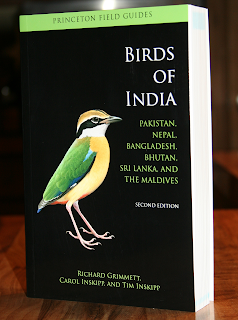I recently received my Birds of India: Pakistan, Nepal, Bangladesh, Bhutan, Sri Lanka, and The Maldives (second edition) in the mail and haven’t been able to get any work done since. For those familiar with the first edition, the authors have put in an exceptional amount of work creating an even better, up to date resource and the most comprehensive field guide for the Indian subcontinent. The 226 plates (72 more than the 1st edition) covers all 1,375 species of residents, migrants and vagrants – and better yet, the range maps and text now mirrors the plates eliminating the hassle of relentlessly flipping through pages. It also includes taxonomical name changes as well as accurate, updated range maps.
As with all field guides, there will always be cons and with this guide there was one that caught my attention. A few of the plates appear to be moderately dark (i.e. shorebirds) – this can either be the artist that covered that section or simply the printers. However, the vast majority of the plates are exceptional and precise.
 |
| Plate 82: Parakeets |
 |
| Plate 124: Jays and Magpies |
Without a doubt, this user-friendly guide is a must for anyone heading to the Indian subcontinent or for those who simply want to add another remarkable field guide to their library. My next backpacking trip will hopefully be the Indian subcontinent and the Birds of India will certainly be the first item packed.
Note: this advanced copy of the Birds of India was sent to me by Princeton Press for review. The paperback publishes on March 7, 2012.


2 comments:
oh my god!!! i want!!
hi ohiobirder
i have ordered this book - Birds of the Indian Subcontinent - A Field Guide
http://www.bnhs.org/publications.html?id=315
i was trying for this book first -
A Photographic Guide to Birds of India and Nepal
~ Bikram Grewal
but the online shopping site was unable to get hold of it
i was in the sunderbans (world's largest mangrove forest - india/bangaldesh - the delta of the ganges) and got to see the cormorant, the grey heron, the egret, and the green bee eater among others. - this is an informative site on indian birds - http://www.kolkatabirds.com/bookreview.htm
cheers
ranjit
Post a Comment